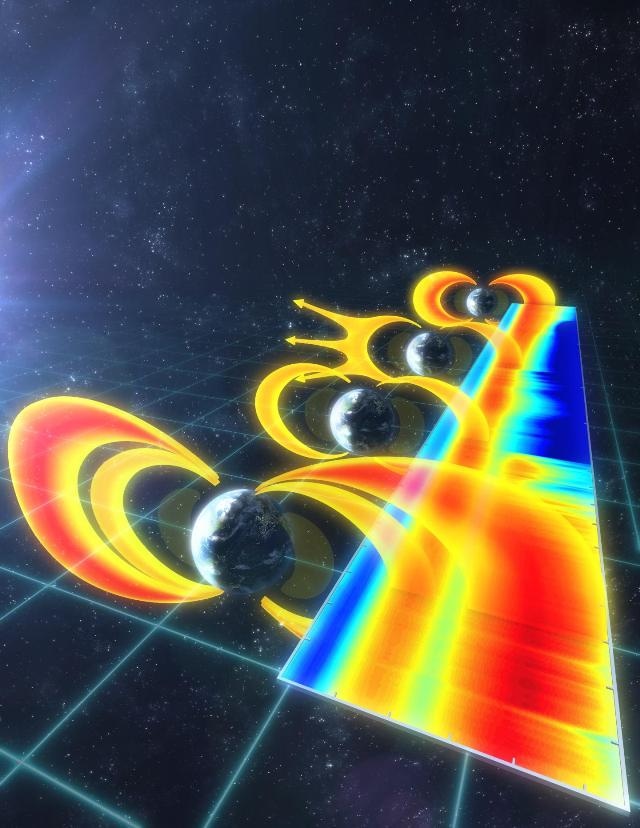Jun 22 2016
The magnetosphere of the Earth protects it from the aggressive battering of the solar wind. It is almost like a protective shield that soaks up and deflects plasma from the solar wind coming from the Sun. The magnetosphere is the region of space where the Earth's magnetic field exists. Stunning dancing auroral displays are produced when conditions are perfect.
 This is an illustration to explain the dynamics of the ultra-relativistic third Van Allen radiation belt, by Andy Kale. (Photo credit: Andy Kale)
This is an illustration to explain the dynamics of the ultra-relativistic third Van Allen radiation belt, by Andy Kale. (Photo credit: Andy Kale)
However if the solar wind are very harsh, intense space weather storms could produce high levels of radiation in the Van Allen belts and drive electrical currents which are capable of destroying electrical power grids on Earth. This could in turn cost up to trillions of dollars in damages.
A novel discovery by a team of researchers from the University of Alberta has been published in Nature Physics. For the first time, the mystery of how the third Van Allen radiation belt is generated by a "space tsunami" has been revealed. Powerful ultra-low frequency (ULF) plasma waves are excited on the scale of the entire magnetosphere. The waves carry the belt radiation’s outer part safely into interplanetary space and produce the formerly mysterious characteristic of the third belt.
Remarkably, we observed huge plasma waves. Rather like a space tsunami, they slosh the radiation belts around and very rapidly wash away the outer part of the belt, explaining the structure of the enigmatic third radiation belt.
Ian Mann, Physics Professor, University of Alberta
The study also highlights the significance of these waves in decreasing the risk of space radiation to satellites during other space storms too. "Space radiation poses a threat to the operation of the satellite infrastructure upon which our twenty-first century technological society relies," adds Mann. "Understanding how such radiation is energized and lost is one of the biggest challenges for space research."
Over the last five decades, and since the inadvertent discovery of the Van Allen belts at the start of the space age, predicting space radiation has become crucial to human space exploration and the functioning of satellites.
The Van Allen belts, christened after their discoverer, are regions within the magnetosphere. Here, high-energy electrons and protons are captured by the magnetic field of the Earth. They have been known since 1958, and were historically categorized into two outer and inner belts. However, in 2013, NASA's Van Allen Probes revealed a mysterious third Van Allen belt that had not formerly been observed. This third Van Allen belt existed for just a few weeks and then it disappeared. The cause for its disappearance is unexplained.
Mann, co-investigator on the NASA Van Allen Probes mission, and his team's key goals were to replicate the process by which plasma waves in the magnetosphere manipulate the dynamics of the powerful relativistic particles in the Van Allen belts. The Van Allen Probes mission hoped to create adequate understanding to realize the point of predictability. The third Van Allen belt’s appearance, one of the first big discoveries of the Van Allen Probes period, had continuously mystified scientists with constantly increasingly intricate explanation models being created.
However, according to the explanation published, once the effects of these enormous ULF waves are included, all factors will be much clearer.
We have discovered a very elegant explanation for the dynamics of the third belt. Our results show a remarkable simplicity in belt response once the dominant processes are accurately specified.
Ian Mann, Physics Professor, University of Alberta
Several of the services humans depend upon today, such as satellite-based telecommunications and GPS, are disturbed by radiation inside the Van Allen belts.
The International Living with a Star (ILWS) Program and international cooperation between a number of global space agencies are all analyzing "satellite killer" electrons that are a risk to satellites. "Satellite killer" electrons are a type of radiation. New socio-economic researches on the effect of a harsh space weather storm have predicted that the cost of the total damage and follow-on effects on space-based and earthly infrastructure could extend to even $2 trillion USD.
Now politicians are also realizing the threat and are keen on tackling the risk from space weather. Recently, The White House announced the achievement of a Space Weather Action Plan pinpointing the significance of space weather research similar to this recent discovery. The action plan aims to lessen the effects of powerful space weather by creating specific actions aiming at mitigation and encouraging global collaboration.
Mann is the lead author of this new research, and is the chairman of an international Space Weather Expert Group operated under the auspices of the United Nations Committee on the Peaceful Uses of Outer Space (COPUOS); the Expert Group has a three-year work plan and is charged with analyzing and creating approaches to deal with the space weather threat with the cooperation of the international community. Canada is located under the auroral zone and therefore faces a much greater impending risk from space weather forces than any other countries.